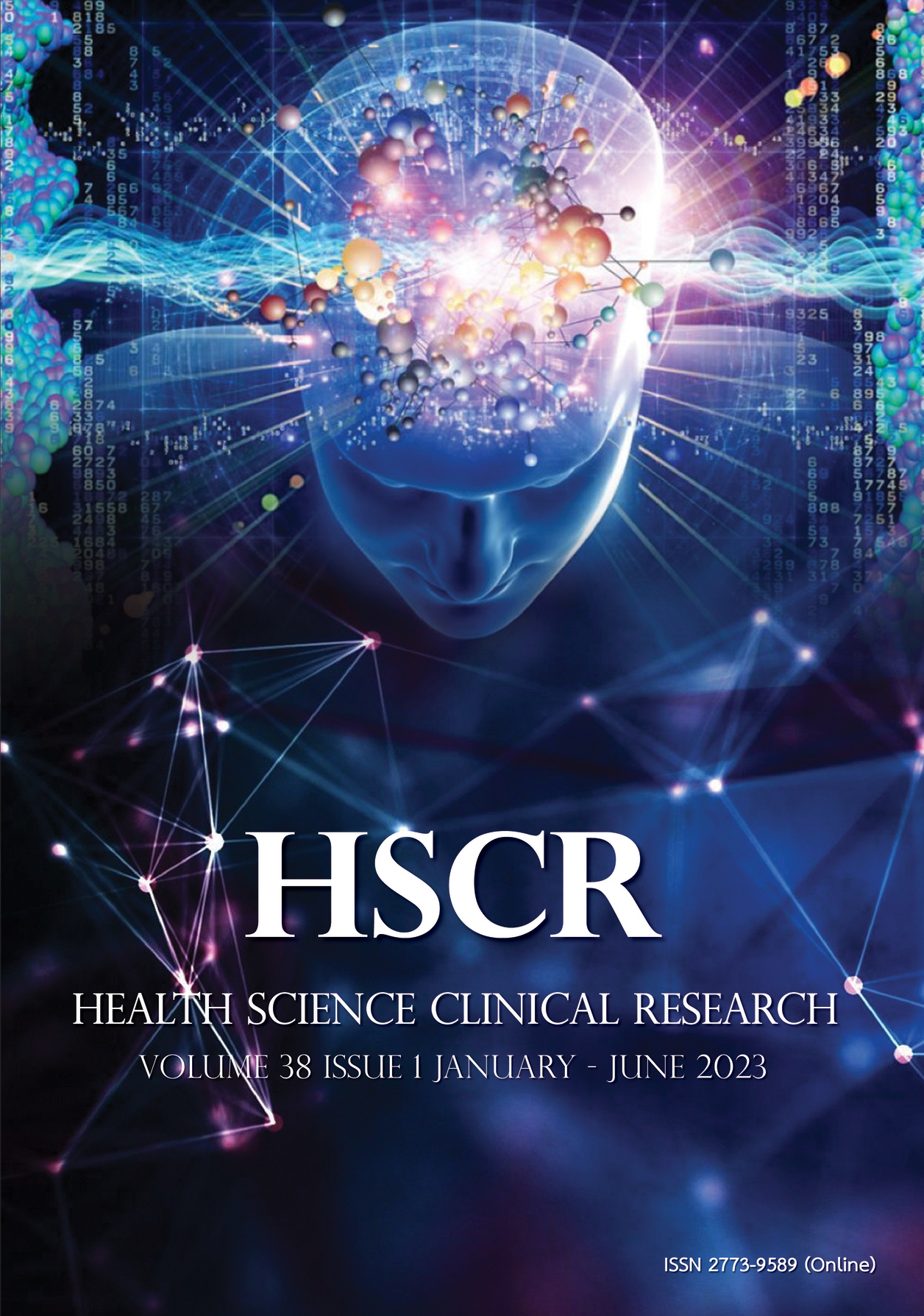Solitary Fibrous Tumor of the Urinary Bladder
DOI:
https://doi.org/10.1016/hscr.v38i1.261065Keywords:
Solitary fibrous tumor, STAT6, CD34Abstract
ABSTRACT
Introduction: Solitary fibrous tumor (SFT) is a rare fibroblastic tumor characterized by pathognomonic NAB2-STAT6 gene fusion on chromosomal region 12q13. It occurs at any anatomical site,including superficial and deep soft tissues and within visceral organs. SFT of urinary bladder is quite rare. In this study, the author presents SFT of urinary bladder case with immunophenotypes and English literature reviews. There are 27 cases, divided into a patient receiving treatment and 26 case studies from relevant English literature reviews. Case presentation: A 45-year-old Thai man presented with progressive lower abdominal pain. Physical examination revealed an intra-abdominal mass palpated in left lower quadrant. A subsequent computed tomography of his abdomen revealed a 5.6x5.1 cm. circumscribed enhancing mass arising from left sided urinary bladder base. He underwent operative transurethral resection of bladder tumor and radical cystectomy. The cut surface of resected urinary bladder revealed a 4x2.5x2.2 cm. homogenous white-tan mass-like lesion located in the bladder trigone. A histologic evaluation revealed haphazard proliferation of spindle cells with fine nuclear chromatin. Staghorn-like blood vessels are frequently observed in dense collagenous stroma. The histological features combined with immunohistochemical studies were suggestive of solitary fibrous tumor that appeared to be growing from submucosa of the urinary bladder. He is currently four months post-surgery without evidence of metastasis or recurrence.
Conclusion: SFT of urinary bladder comprise a histologic features of mesenchymal neoplasms that show fibroblastic differentiation. The clinical presentations were variable and non-specific. Immunohistochemical studies played an important role for diagnosis and differentiating SFT from other spindle cell mesenchymal tumors. Prognostic factors are age, tumor size, mitotic figure, focal necrosis, and surgical margin status. Clinical and biological behaviors are usually benign and can be predicted based on the pathological features. Complete surgical resection is the gold standard of treatment. Chemotherapy and adjuvant radiation therapy can be considered in case of nonresectable tumor or metastasis.
Keywords: Solitary fibrous tumor, Urinary bladder, STAT6, CD34
References
WHO Classification of Tumours Editorial Board. Soft Tissue and Bone Tumours. 5th ed. Lyon (France): International Agency for Research on Cancer; 2020.
John R. Goldblum, Andrew L. Folpe, Sharon W. Weiss. Enzinger and Weiss’s soft tissue tumors. 6th ed. Elsevier Health Sciences; 2014.
National cancer institute. Cancer Stat Facts: Bladder Cancer [Internet]. Available from: https://seer.cancer.gov/statfacts/html/urinb.html
สถาบันมะเร็งแห่งชาติ กรมการแพทย์ กระทรวงสาธารณสุข. Cancer in Thailand 2016-2018. 2021;10. Available from: https://www.nci.go.th/e_book/cit_x/index.html
Wang T, Chen R, Qiao J, Hu T, Liu J, Yang W, et al. Solitary fibrous tumor in bladder: a case report. J Huazhong Univ Sci Technolog Med Sci [Internet]. 2010 Jun;30(3):412–4. Available from: http://www.ncbi.nlm.nih.gov/pubmed/20556592
Cheng SH, Wang SS, Lee CH, Ou YC, Cheng CL. Malignant solitary fibrous tumor of the urinary bladder. J Chinese Med Assoc [Internet]. 2012 Sep;75(9):479–82. Available from: https://journals.lww.com/02118582-201209000-00011
Seike K, Kameyama K, Kato T, Tsuchiya T, Yasuda M, Yokoi S, et al. [Solitary fibrous tumor of the urinary bladder: a case report]. Hinyokika Kiyo [Internet]. 2012 Feb;58(2):105–8. Available from: http://www.ncbi.nlm.nih.gov/pubmed/22450839
Wang C, Miyago N, Harada Y, Yasunaga Y, Oka T. SOLITARY FIBROUS TUMOR OF THE URINARY BLADDER: A CASE REPORT. Japanese J Urol [Internet]. 2012;103(4):640–3. Available from: https://www.jstage.jst.go.jp/article/jpnjurol/103/4/103_640/_article/-char/ja/
Otta RJ, Acosta MA, Gordillo C. A rare case of solitary fibrous tumour of the bladder. Can Urol Assoc J [Internet]. 2014 Jul;8(7–8):E552-3. Available from: http://www.ncbi.nlm.nih.gov/pubmed/25210562
Spairani C, Squillaci S, Pitino A, Ferrari M, Montefiore F, Rossi C, et al. A Case of Concomitant Occurrence of Solitary Fibrous Tumor and Urothelial High-Grade Invasive Carcinoma of the Urinary Bladder. Int J Surg Pathol [Internet]. 2014 May 19;22(3):252–9. Available from: http://journals.sagepub.com/doi/10.1177/1066896913481061
Tanaka EY, Buonfiglio VB, Manzano JP, Filippi RZ, Sadi MV. Two Cases of Solitary Fibrous Tumor Involving Urinary Bladder and a Review of the Literature. Case Rep Urol [Internet]. 2016;2016:1–5. Available from: https://www.hindawi.com/journals/criu/2016/5145789/
Tian TT, Wu JT, Hu XH, Yang GM, Sun J, Chen WX, et al. Imaging findings of solitary fibrous tumor in the abdomen and pelvis. Abdom Imaging [Internet]. 2014 Dec 15;39(6):1323–9. Available from: http://link.springer.com/10.1007/s00261-014-0155-4
Gupta N, Aji S. Solitary fibrous tumor mimicking prolapsed ureteral polyp. Indian J Urol [Internet]. 2015;31(4):358. Available from: http://www.indianjurol.com/text.asp?2015/31/4/358/163311
Dozier J, Jameel Z, McCain DA, Hassoun P, Bamboat ZM. Massive malignant solitary fibrous tumor arising from the bladder serosa: a case report. J Med Case Rep [Internet]. 2015 Dec 1;9(1):46. Available from:https://jmedicalcasereports.biomedcentral.com/articles/10.1186/s13256-014-0505-4
Gao C, Zhang Y, Li YY, Yu YH, Qu W, Gao YS, et al. Postoperative recurrence solitary fibrous tumor of the pelvic with malignant transformation. Int J Clin Exp Med [Internet]. 2015;8(9):16827–33. Available from: http://www.ncbi.nlm.nih.gov/pubmed/26629228
ISHIHARA H, OMAE K, IIZUKA J, KOBAYASHI H, FUKUDA I, KONDO T, et al. Late recurrence of a malignant hypoglycemia-inducing pelvic solitary fibrous tumor secreting high-molecular-weight insulin-like growth factor-II: A case report with protein analysis. Oncol Lett [Internet]. 2016 Jul;12(1):479–84. Available from: https://www.spandidos-publications.com/10.3892/ol.2016.466
Mustafa HJ, Menon S. Solitary Fibrous Tumor in a Female Urinary Bladder. Urol Case Reports [Internet]. 2016 Jul;7:1–2. Available from: https://linkinghub.elsevier.com/retrieve/pii/S221444201630016X
Ruan HJ, Huang AH, Cheng S, Fu GX. [Clinicopathologic features of solitary fibrous tumor in urogenital system]. Zhonghua bing li xue za zhi = Chinese J Pathol [Internet]. 2016 Apr 8;45(4):248–51. Available from: http://www.ncbi.nlm.nih.gov/pubmed/27033388
Tong X nan, Cheng T, Zhang M, Zhang S yu, Li S, Gao Y, et al. A Case of Huge Solitary FibrousTumor in Bladder. Clin Genitourin Cancer [Internet]. 2017 Feb;15(1):e105–10. Available from: https://linkinghub.elsevier.com/retrieve/pii/S1558767316302208
Kouba E, Simper NB, Chen S, Williamson SR, Grignon DJ, Eble JN, et al. Solitary fibrous tumour of the genitourinary tract: a clinicopathological study of 11 cases and their association with the NAB2 - STAT6 fusion gene. J Clin Pathol [Internet]. 2017 Jun;70(6):508–14. Available from: http://jcp.bmj.com/lookup/doi/10.1136/jclinpath-2016-204088
Tan GHC, Ng D, Hennedige T, Teo M. A solitary fibrous tumour mimicking an aggressive angiomyxoma/liposarcoma. BMJ Case Rep [Internet]. 2017 May 5;bcr2016-218202. Available from: https://casereports.bmj.com/lookup/doi/10.1136/bcr-2016-218202
Prunty MC, Gaballah A, Ellis L, Murray KS.Solitary Fibrous Tumor of the Pelvis Involving the Urinary Bladder. Urology [Internet]. 2018 Jul;117:27–30. Available from: https://linkinghub.elsevier.com/retrieve/pii/S0090429518300207
Rovegno FA, Hernandez CY, Gradin S, Spir AR, Rovegno AR. Solitary Fibrous Tumor of the pelvis involving the bladder. Case report and literature review. Urol Case Reports [Internet]. 2019 May;24:100864. Available from: https://linkinghub.elsevier.com/retrieve/pii/S2214442019300609
Cheng Q, Chang X, Chen W, Qin J, Ai Q, Li H. A rare case of solitary fibrous tumor arising from prostate located inside of bladder. Urol Case Reports [Internet]. 2019 May;24:100880. Available from: https://linkinghub.elsevier.com/retrieve/pii/S221444201930083X
Kratiras Z, Spapis V, Koniaris E, Kozyrakis D, Skriapas K. Malignant solitary fibrous tumor of urinary bladder: A rare clinical entity. Arch Ital di Urol e Androl [Internet]. 2019 Jul 2;91(2). Available from:https://pagepressjournals.org/index.php/aiua/article/view/aiua.2019.2.135
Urbina-Lima ÁD, Román-Martín AÁ, CrespoSantos A, Martínez-Rodríguez A, Cienfuegos-Belmonte IR, Olmo-Ruiz M, et al. Solitary Fibrous Tumor of the Urinary Bladder Associated with Hypoglycemia: An Unusual Case of Doege-Potter Syndrome. Urol Int [Internet]. 2019;103(1):120–4. Available from: https://www.karger.com/Article/FullText/499942
Sun S, Tang M, Dong H, Liang C, Yan T, Li J, et al. Solitary fibrous tumor involving urinary bladder: a case report and literature review. Transl Androl Urol [Internet]. 2020 Apr;9(2):766–75. Available from: http://tau.amegroups.com/article/view/36281/30236
Klemperer P, Rabin CB. Primary Neoplasms of the pleura. A report of five cases. Am J Ind Med [Internet]. 1992;22(1):4–31. Available from: https://onlinelibrary.wiley.com/doi/10.1002/ajim.4700220103
WHO Classification of Tumours. Soft tissue and Bone Tumours. 4th ed. Christopher D.M. Fletcher, Julia A. Bridge, Pancras C.W. Hogendoorn, Fredrik Mertens, editors. Lyon (France): International Agency for Research on Cancer; 2013.
Manica M, Roscigno M, Naspro R, Sodano M, Milesi L, Gianatti A, et al. Recurrent retroperitoneal solitary fibrous tumor: a case report. Tumori [Internet]. 2021 Dec;107(6):NP11–4. Available from: http://www.ncbi.nlm.nih.gov/pubmed/33238803
Vargas JF, Gandhi D, Bajaj D, Serhal M, Erazo IS, Singh J. Solitary fibrous tumor of the urinary bladder: An unusual case report with literature review. Radiol Case Reports [Internet]. 2021 Dec;16(12):3898–902. Available from:https://linkinghub.elsevier.com/retrieve/pii/S1930043321006816
Doyle LA, Vivero M, Fletcher CD, Mertens F, Hornick JL. Nuclear expression of STAT6 distinguishes solitary fibrous tumor from histologic mimics. Mod Pathol [Internet]. 2014 Mar;27(3):390–5. Available from: https://linkinghub.elsevier.com/retrieve/pii/S0893395222018294
Cheah AL, Billings SD, Goldblum JR, Carver P, Tanas MZ, Rubin BP. STAT6 rabbit monoclonal antibody is a robust diagnostic tool for the distinction of solitary fibrous tumour from its mimics. Pathology [Internet]. 2014 Aug;46(5):389–95. Available from: https://linkinghub.elsevier.com/retrieve/pii/S0031302516305529
Yoshida A, Tsuta K, Ohno M, Yoshida M, Narita Y, Kawai A, et al. STAT6 Immunohistochemistry Is Helpful in the Diagnosis of Solitary Fibrous Tumors. Am J Surg Pathol [Internet]. 2014 Apr;38(4):552–9. Available from: https://journals.lww.com/00000478-201404000-00014
Schweizer L, Koelsche C, Sahm F, Piro RM, Capper D, Reuss DE, et al. Meningeal hemangiopericytoma and solitary fibrous tumors carry the NAB2-STAT6 fusion and can be diagnosed by nuclear expression of STAT6 protein. Acta Neuropathol [Internet]. 2013 May 11;125(5):651–8. Available from: http://link.springer.com/10.1007/s00401-013-1117-6
HANAU C. Solitary fibrous tumor: Histological and immunohistochemical spectrum of benign and malignant variants presenting at different sites. Hum Pathol [Internet]. 1995 Apr;26(4):440–9. Available from: https://linkinghub.elsevier.com/retrieve/pii/0046817795901477
Vallat-Decouvelaere AV, Dry SM, Fletcher CDM. Atypical and Malignant Solitary Fibrous Tumors in Extrathoracic Locations. Am J Surg Pathol [Internet]. 1998 Dec;22(12):1501–11. Available from: http://journals.lww.com/00000478-199812000-00007
Robinson DR, Wu YM, Kalyana-Sundaram S, Cao X, Lonigro RJ, Sung YS, et al. Identification of recurrent NAB2-STAT6 gene fusions in solitary fibrous tumor by integrative sequencing. Nat Genet [Internet]. 2013 Feb 13;45(2):180–5. Available from: http://www.nature.com/articles/ng.2509
Mohajeri A, Tayebwa J, Collin A, Nilsson J, Magnusson L, von Steyern FV, et al. Comprehensive genetic analysis identifies a pathognomonic NAB2/STAT6 fusion gene, nonrandom secondary genomic imbalances, and a characteristic gene expression profile in solitary fibrous tumor. Genes, Chromosom Cancer [Internet]. 2013 Oct;52(10):873–86. Available from: https://onlinelibrary.wiley.com/doi/10.1002/gcc.22083
Chuang IC, Liao KC, Huang HY, Kao YC, Li CF, Huang SC, et al. NAB2-STAT6 gene fusion and STAT6 immunoexpression in extrathoracic solitary fibrous tumors: the association between fusion variants and locations. Pathol Int [Internet]. 2016 May;66(5):288–96. Available from: https://onlinelibrary.wiley.com/doi/10.1111/pin.12408
Tai HC, Chuang IC, Chen TC, Li CF, Huang SC, Kao YC, et al. NAB2–STAT6 fusion types account for clinicopathological variations in solitary fibrous tumors. Mod Pathol [Internet]. 2015 Oct;28(10):1324–35. Available from: https://linkinghub.elsevier.com/retrieve/pii/S0893395222013643
Barthelmeß S, Geddert H, Boltze C, Moskalev EA, Bieg M, Sirbu H, et al. Solitary Fibrous Tumors/Hemangiopericytomas with Different Variants of the NAB2-STAT6 Gene Fusion Are Characterized by Specific Histomorphology and Distinct Clinicopathological Features. Am J Pathol [Internet]. 2014 Apr;184(4):1209–18. Available from: https://linkinghub.elsevier.com/retrieve/pii/S0002944014000212
Mosquera JM, Fletcher CDM. Expanding the Spectrum of Malignant Progression in Solitary Fibrous Tumors. Am J Surg Pathol [Internet]. 2009 Sep;33(9):1314–21. Available from:https://journals.lww.com/00000478-200909000-00007
Espat NJ, Lewis JJ, Leung D, Woodruff JM, Antonescu CR, Shia J, et al. Conventional hemangiopericytoma. Cancer [Internet]. 2002 Oct 15;95(8):1746–51. Available from: https://onlinelibrary.wiley.com/doi/10.1002/cncr.10867
Bishop AJ, Zagars GK, Demicco EG, Wang WL, Feig BW, Guadagnolo BA. Soft Tissue Solitary Fibrous Tumor. Am J Clin Oncol [Internet]. 2018 Jan;41(1):81–5. Available from: https://journals.lww.com/00000421-201801000-00014
Demicco EG, Park MS, Araujo DM, Fox PS, Bassett RL, Pollock RE, et al. Solitary fibrous tumor: a clinicopathological study of 110 cases and proposed risk assessment model. Mod Pathol [Internet]. 2012 Sep;25(9):1298–306. Available from: https://linkinghub.elsevier.com/retrieve/pii/S0893395222029921
Gholami S, Cassidy MR, Kirane A, Kuk D, Zanchelli B, Antonescu CR, et al. Size and Location are the Most Important Risk Factors for Malignant Behavior in Resected Solitary Fibrous Tumors. Ann Surg Oncol [Internet]. 2017 Dec 16;24(13):3865–71. Available from: http://link.springer.com/10.1245/s10434-017-6092-z
Salas S, Resseguier N, Blay JY, Le Cesne A, Italiano A, Chevreau C, et al. Prediction of local and metastatic recurrence in solitary fibrous tumor: construction of a risk calculator in a multicenter cohort from the French Sarcoma Group (FSG) database. Ann Oncol [Internet]. 2017 Aug;28(8):1779–87. Available from: https://linkinghub.elsevier.com/retrieve/pii/S0923753419321702
Pasquali S, Gronchi A, Strauss D, Bonvalot S, Jeys L, Stacchiotti S, et al. Resectable extra-pleural and extra-meningeal solitary fibrous tumours: A multi-centre prognostic study. Eur J Surg Oncol [Internet]. 2016 Jul;42(7):1064–70. Available from: https://linkinghub.elsevier.com/retrieve/pii/S0748798316000937
Friis RB, Safwat A, Baad-Hansen T, Aggerholm-Pedersen N. Solitary Fibrous Tumour: A Single Institution Retrospective Study and Further Validation of a Prognostic Risk Assessment System. Clin Oncol [Internet]. 2018 Dec;30(12):798–804. Available from: https://linkinghub.elsevier.com/retrieve/pii/S0936655518304242
Downloads
Published
How to Cite
Issue
Section
License
Copyright (c) 2023 Health Science Clinical Research

This work is licensed under a Creative Commons Attribution-NonCommercial-NoDerivatives 4.0 International License.
The names and email addresses entered in this journal site will be used exclusively for the stated purposes of this journal and will not be made available for any other purpose or to any other party.















